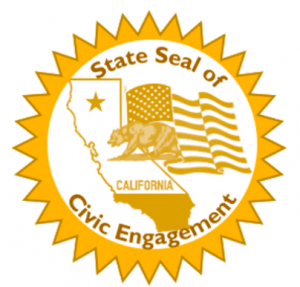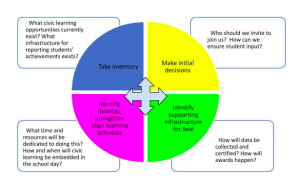California adopted the State Seal of Civic Engagement in the Fall of 2020. It is designed to honor and award students who demonstrate extended and deep civic engagement through meeting five criteria. We are excited about this initiative, not only because it explicitly recognizes the importance of civic learning and education for California’s youth, but it is also an opportunity to focus on integrating civic learning across the K-12 curriculum. We look forward to working with you to seize this opportunity to focus on equitable and universal access to powerful civic learning across the curriculum.
We are especially excited by the potential of Criteria 3, which states:
“The student must participate in one or more informed civic engagement project(s) that address real-world problems and require students to identify and inquire into civic needs or problems, consider varied responses, take action, and reflect on efforts.”
This informed civic engagement project potentially embeds much of what we understand as powerful teaching and learning, including purposeful and literacy-rich inquiry, problem-based learning, and student voice and choice. And, it can be a lever for offering equitable civic learning opportunities for all the students in your district or school through planning across multiple grade levels and courses.
We are building some tools to help you start thinking about implementing the Seal in your school(s). These tools are designed as working drafts and we welcome feedback about what is useful and what is not and how you modify them. Currently, this is a packet in process and more tools will be added (check back for more soon). Each of the tools contains a cover page and can be used to take inventory, map and plan approaches, and will eventually include an example.
Use these tools to:
- Gain familiarity with the California State Seal for Civic Learning.
- Take a local inventory of existing civic learning and opportunities and identify action items to develop additional avenues for civic learning.
- Begin thinking about the informed civic engagement project as a catalyst for collaborations and articulations across grade levels and content areas.
Our Focus on Civics
Civics has been an emphasis of our Project from its start in 2018. One of our first acts as a new CHSSP Project was to join the CivXNow network and we have designed our programs with civic and historical learning at the forefront. These include our 2020 Teaching with Primary Sources Workshop: What makes a Democracy?; and our co-produced series with CHSSP partners, “Discord and Crisis: the 2020 Election”; and “Building Students’ Media Literacy for Civic Engagement,” and source sets that allow students to investigate the American Paradox or voting rights. Director Daisy Martin has been serving on the Civic Engagement Work Group (CEWG), organized by the California Department of Education, and our partnership with Salinas Union High School District has allowed us the honor of working with their stellar group in building plans for access to the Civic Seal and civic learning. Read about one student’s experience and insights into that process here.
Additional Resources
For more helpful targeted tools and resources, visit the California Department of Education and other organizations’ and educators’ sites. Also see the selected reports below for some guiding frameworks.
| Key Recent Reports and Frameworks Regarding Civic Learning | |
| California | National |
| Educating for Democracy: Civic Education in the CA History-Social Science Framework | College, Career, and Civic Life (C3) Framework |
| Civic Learning Compendium | Educating For American Democracy |
| Reclaiming the Democratic Purpose of California’s schools | National Academy of Education Report: Educating for Civic Reasoning and Discourse |




